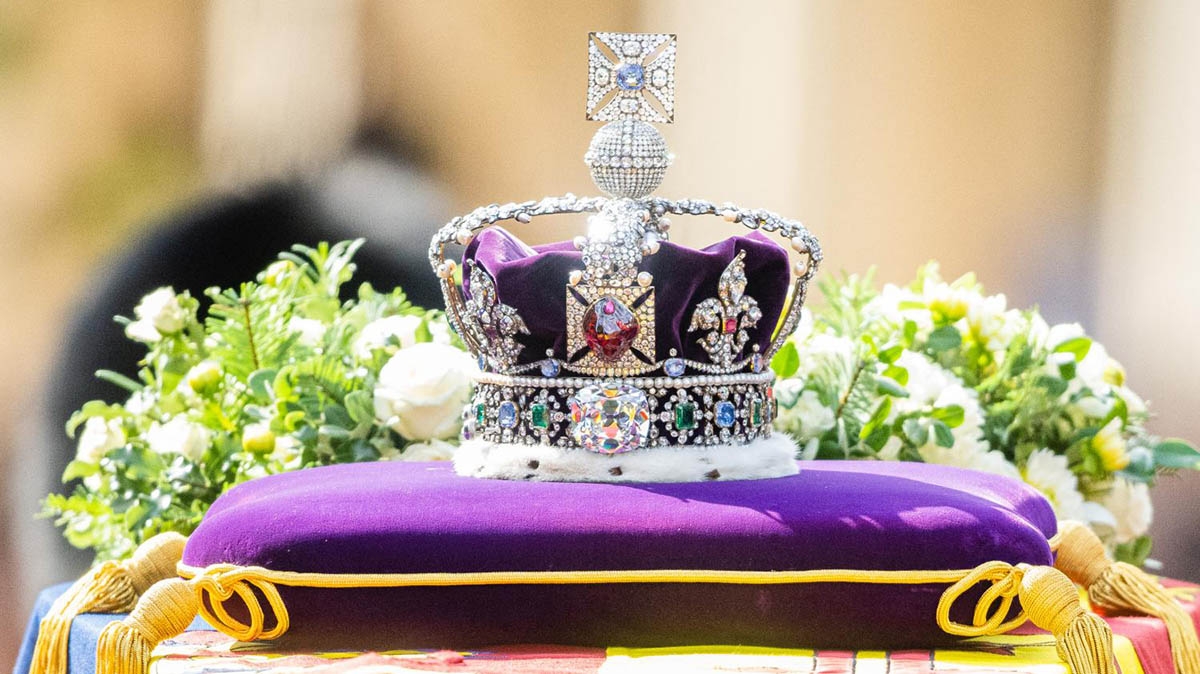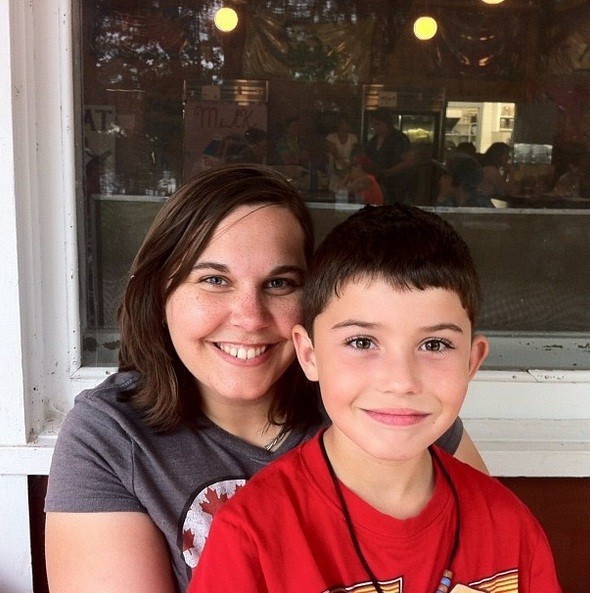
The stunning gemological collection in the Imperial State Crown
The passing of Queen Elizabeth II and the ascension of King Charles III provides a rare opportunity to see some of the collection of the Crown Jewels of the United Kingdom. Chief among them is the Imperial State Crown, centred over the royal standard draping the Queen’s coffin as she lies in state until her funeral on Monday. The passing of Queen Elizabeth II and the ascension of King Charles III provides a rare opportunity to see some of the collection of the Crown Jewels of the United Kingdom.
Numerous versions of the Imperial State Crown were created since the restoration of the monarchy in 1660. The current State Crown is based on that made for Queen Victoria in 1838 by London jewellers Rundell, Bridge & Co. It weighed almost 40 troy ounces, or more than 1,200 grams, but no doubt feeling more like a ton perched on the royal head after a lengthy State ceremony. The troy ounce, as an aside, is the measurement used for precious metals. It’s the last holdout of the measurement, which originated in Troyes, France, and dates back at least to the Middle Ages. It converts to 31.1 grams, whereas standard ounces (avoirdupois), as used for all other commodities, equals 28.35 grams.
The crown's weight comes from the mine’s worth of gems encrusting the headpiece. Mainly though the weight would come from the precious metal used to set them all. Gem weight is measured in ‘carats’ (a term derived from the ancient use of the carob seed as a unit of measure), and five of them equal a gram. Not particularly heavy. Precious metals, though, particularly platinum, are very weighty and very durable. Apparently though, not durable enough. At the State Opening of Parliament in 1845, the crown, being carried on a cushion to the Queen, went for a tumble and collapsed. The Queen later wrote, "it was all crushed and squashed like a pudding that had sat down." That’s some pudding.
Of the diamonds set in Queen Victoria’s crown, they were described in Scientific American, on December 14, 1861, as including 1,363 brilliant cut, 1,273 rose cut, and 147 table cut gems. The latter two had been common cuts for a few hundred years. The use of the term ‘brilliant’ cut is to be read askance; it is certainly not the equivalent of today’s use of the term. The would have been old mine or European cuts, forerunners of the ‘brilliant’ cut as we now know it: the 57 (or 58) facet cut seen on round diamonds. This is a cutting style developed by the renowned gem-cutter Marcel Tolkowsky in the early 1900s, after much scientific consideration. It’s a cut that maximizes the brilliance (brightness), scintillation (flashes of light and contrasting darkness), and fire (flashes of colour) of diamonds as it forces light that has entered the gem to rebound like a pinball within the interior of the gem and then return to the viewer’s eye through the top or crown of the gem. Angles and proportions are exacting to ensure this light play. But it was a science not fully developed in the 19th century.
Also curious in this cataloguing is the reference to the Black Prince’s Ruby as, well, a ruby. We still call that incredible gem that graces the crown front and centre the Black Prince’s ‘Ruby’ but now know it to be a spinel, a completely different species of gem. At the time of the magazine’s publication, gemological science had advanced enough to differentiate spinel from corundum, the red version of which is ruby. In 1783, mineralogist Jean Baptiste Louis Rome de Lisle identified spinel. Prior to that, most red stones were simply called rubies.
According to renowned coloured gem expert Richard Hughes, the Black Prince's Ruby was probably mined in what is now Tajikistan. Its first documented appearance was in 14th century Spain when it was owned by a succession of Moorish and Spanish kings and then given as payment to Edward, Prince of Wales, the Black Prince, by Don Pedro, King of Castile, for victory in the Battle of Najera in 1367.
The irregular cabochon (that is, an unfaceted gem) passed on to many other English monarchs, including Henry VIII. It outlasted sovereigns, survived fires, an attempted theft, and World War II bombing raids, and remains a centerpiece of England’s Crown Jewels. It weighs approximately 170 cts and has a drill hole at the top, now capped by a small ruby, as it was once used as a pendant. Apparently, a past king also placed a feather into the drill hole. "It's fun to see," the Queen told the BBC in 2018, "the idea that his plume was put into the stone on his helmet – bit rash, but that was the sort of thing they did, I suppose, in those days."
In 1937, the crown was remodelled for the coronation of Queen Elizabeth’s father, King George VI. It was slightly altered again for her coronation in 1953 to reduce the head size and lower the height to make it more feminine. Still no shortage of gems and precious metals, though. It is decorated with 2,868 diamonds, 273 pearls, 17 sapphires, 11 emeralds, and 5 rubies. The frame is made of gold, silver, and platinum, making it a challenge to wear for any length of time. As the Queen joked in a BBC interview in 2018, "You can't look down to read the speech; you have to take the speech up because if you did, your neck would break."
Many of the gems from the previous crown were included in the new one. The Black Prince’s ruby/spinel is still in a place of prominence. But the real show-stopper is front and centre: the jaw-dropping Cullinan II diamond, weighing 317.4 carats (or 63.48 grams). It is the second largest of the nine large gems (and numerous smaller ones) cut from the largest piece of diamond rough ever unearthed, the Cullinan. Discovered at the Premier Mine near Pretoria, South Africa, and named after its Chairman, the rough weighed an incredible 3,106 carats, about the size of a human heart, and of exceptionally rare quality. It remains the largest colourless diamond ever to be mined.
The stone was presented to Edward VII in 1907 as a symbolic gesture to heal the rift between Britain and South Africa after the Boer War. To get the gem safely from South Africa to the UK, a huge ruse was set up, and international attention focussed on the ‘decoy’ ship with armed guards and military personnel that headed to London. Instead, the gem was wrapped in a simple parcel and posted to the London office of one of the mine’s associates. This stunt was pulled again when the gem was sent to be cut by the famous Asscher Diamond Company in Amsterdam. Once again, military convoy; once again, the gem was simply expedited in the pocket of Abraham Asscher’s greatcoat on a passenger ship he took across the Channel.
Cullinan I, or the Great Star of Africa, is a pendeloque-cut brilliant, weighing 530.2 carats (106.04 g) and has 74 facets. A pendeloque is a pear-shaped cut modified from a round brilliant cut. It too, is included in the trove of Crown Jewels of the United Kingdom, having been set in the Sovereign's Sceptre with Cross, which also now rests upon the Queen’s coffin. But that’s not all. The Cullinan rough also produced stones III-IX, plus 96 smaller diamonds. Among others, Cullinan III, a 94.40 ct pear-shaped, and IV, a 63.60 ct square cushion, were given to Queen Mary in 1910. The family joke on these family jewels is ‘Granny’s chips.’ Chips indeed.
Two sapphires of note are also in the crown, one of which dates back almost a thousand years, St. Edward’s Sapphire. It is said to have been set on the coronation ring of King Edward the Confessor, later St. Edward, who ascended the throne in 1042 A.D. This is the vivid blue rose cut gem set in the centre of a cross pattée. The rose cut speaks to an early era but not that early. It is a cutting style that goes back centuries (but not to the 11th) and would not now be used on a sapphire of this magnitude: flat-backed, no table, triangular facets arranged in a symmetrical radiating pattern.
But it’s the legend that is interesting. As the tale goes, King Edward, accosted by a beggar but having no money on him to give, presented the beggar with his ring. The beggar in his guise was St. John the Evangelist, who, in turn, later assisted two English pilgrims in Syria in gratitude for the King’s earlier help. He asked them to return the ring to the King on his behalf and tell Edward that he’d see him in Paradise in six months. They did so, and King Edward began preparations for his funeral. He died six months later in 1066 and was buried with the ring in Westminster Abbey. In the 12th century, the tomb was opened, Edward reinterred, and his regalia, including the ring, were removed. Centuries later, the gem was set into the Imperial State Crown for Queen Victoria. It carried through on the remodelled crown in a place of prominence.
Another large gem of note and history is the Stuart Sapphire. This 104 ct oval cabochon has a drill hole like the Black Prince’s Ruby, and likely it too was once worn as a pendant. Tsk. Not something we’d consider now on any gems beyond pearls and a few others, but such was the understanding and tools of the times.
Its early history is obscure but is referenced as far back as the 17th century. Like many famous gems, it was peripatetic. Not only was it undoubtedly mined in Asia, but the gem also was smuggled out of England to France by James II when he fled in December 1688; it was passed on to his son Prince James Francis Edward, then into the collection of Henry, Cardinal of York. Then retrieved from a Venetian merchant and returned to England. Eventually, the gem was set in the front of the State Crown made for Queen Victoria’s coronation. It got bumped to the back of the crown when the Cullinan II was added, that diamond not being a gem to take a back seat to any others.
While you can look, you certainly cannot touch. Only three people are allowed to touch the crown: the monarch, the Archbishop of Canterbury during the coronation ceremony, and the Crown Jeweller, who is responsible for the crown's maintenance and security whenever it leaves the Tower of London, where it is kept on display in the Jewel House. But be sure to look. This crown is rarely used, and it is a spectacular gemological collection befitting, well, a Queen. May she rest in peace.
Pamela Coulston is a certified gemologist and owner of Disegno Fine Jewellery. Visit Disegno Fine Jewellery in Ottawa's ByWard Market or shop online
PHOTO: Times, UK













